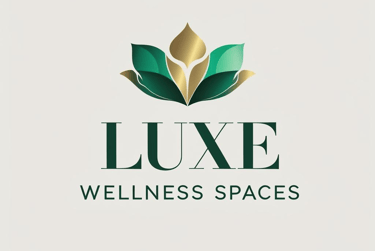Why Social Wellness Clubs Generate 2.5x Better Returns
Social wellness clubs deliver 10-25% property premiums and 80%+ retention. Learn how this $913B market transforms hospitality ROI for savvy developers.
Daryn Berriman
11/12/202511 min read
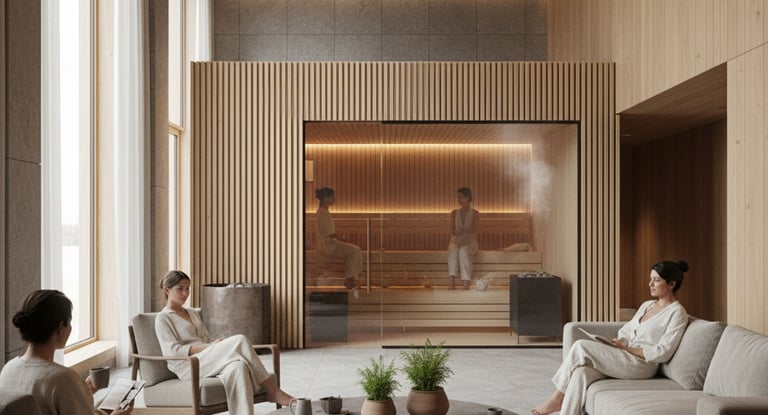

A 75,000-square-foot private club in Los Angeles charges $350 per month and includes a Michelin-starred restaurant, nine boutique fitness studios, and co-working spaces. It's not trying to be a gym. In New York, another club charges $10,000 monthly for AI-powered biometric wellness plans capped at 250 members. Meanwhile, a Toronto bathhouse concept raised $20.6 million to expand its $51-per-month social sauna experience to 20 North American cities.
What makes social wellness clubs a high-ROI business model?
Social wellness clubs generate superior returns through three financial mechanisms: they command 10-25% property value premiums as wellness real estate anchors, achieve 80%+ member retention rates compared to 60% at traditional gyms, and diversify revenue through membership fees, ancillary services, food and beverage, and corporate events rather than relying on single-stream income. The wellness real estate sector that houses these clubs grew at 18.1% annually from 2019-2023 and projects 15.8% growth through 2028, making it the fastest-growing segment of the $6.3 trillion global wellness economy.
Why It Matters: The Stakes
The U.S. Surgeon General declared loneliness a public health epidemic in 2023, with about one in two American adults reporting experiences of loneliness. This isn't a social trend. It's a $6.7 billion annual Medicare cost driver and a market gap worth addressing.
For hospitality operators, the data is clear: 57% of active consumers state that social interaction and connection are the main reasons they join a fitness community, according to ABC Fitness data tracking 30,000 gyms. Your guests aren't buying access to equipment anymore. They're buying belonging.
Consider what happened when Remedy Place, a "social self-care" club in Los Angeles, shifted its revenue model. The company's out-of-club events business grew 65% year-over-year, facilitating over 13,000 ice baths for corporate partners, including BMW, HBO, and Coachella. That's revenue your traditional spa left on the table.
The Convergence That Created a New Asset Class
Social wellness clubs sit at a profitable intersection.
The global wellness economy reached $6.3 trillion in 2023, representing 6.03% of global GDP. Within this massive market, three high-growth sectors converge to create the social wellness club model.
First, wellness real estate. This sector reached $438 billion globally in 2023, more than doubling since 2019, with a remarkable 18.1% compound annual growth rate. Traditional real estate construction? Growing at 5.1% CAGR. The gap tells you where capital is flowing.
Second, mental wellness services. The mental wellness sector projects growth from $181 billion in 2022 to $330 billion by 2027, a 12.2% CAGR. Social wellness clubs aren't selling massages. They're selling solutions to isolation.
Third, the private club business model. The private members' club market projects growth from $31.7 billion in 2024 to $59.1 billion by 2033. Recurring revenue. Exclusivity. Community. These aren't new concepts, but they're being reimagined for a generation that medicalized their mental health.
Revenue Diversification Traditional Spas Can't Match
Walk into a traditional hotel spa. Most revenue comes from treatments. Labor costs eat 55% of that revenue. But social wellness clubs shift focus to recovery equipment, social bathing like communal saunas and ice baths, and group wellness experiences, reducing labor costs from 55% to 20% or less of total wellness revenue.
That's not incremental improvement. That's a fundamental restructuring of your cost base.
A 2024 Skift report found that 85% of hoteliers expect ancillary services to become a primary revenue driver by 2025. Social wellness clubs are purpose-built for this reality.
Here's what diversified revenue actually looks like in practice:
Remedy Place's model includes:
Membership fees for facility access
À la carte high-tech services: IV vitamin drips, hyperbaric chambers, biometric testing
Corporate event hosting that generated 65% revenue growth, with partners like BMW and HBO
Product lines include an $11,000 Remedy Roller, which the founder says "may end up bigger than our brick-and-mortar presence."
The Well's approach:
$375 monthly membership plus $500 registration fee
À la carte practitioner sessions, with 60-minute massages starting at $180
Corporate wellness partnerships and resort collaborations with Auberge Resorts Collection
Some private clubs generate 30-40% of total revenue from business services, including private office rentals, event hosting, and specialized programming. Your wellness amenity becomes your business center. Your spa becomes your event venue. Your fitness studio becomes your corporate retreat space.
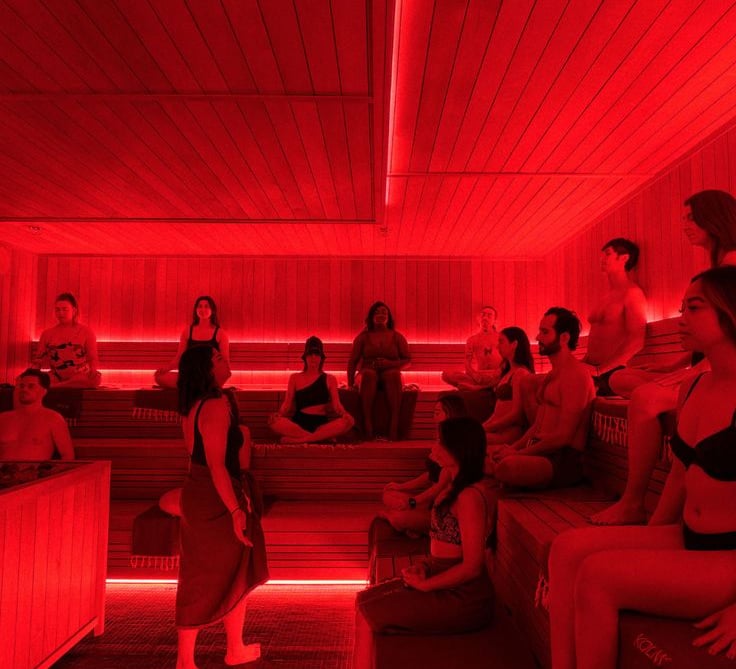

The Retention Math That Changes Everything
Acquiring a new member costs five to 25 times more than retaining an existing one. Analysis shows that increasing member retention from 50% to 80% results in a 2.5x increase in member lifetime value.
Traditional gyms? 60.6% average retention.
Boutique fitness studios focused on community? 75.9% retention.
Personal training studios? 80% retention.
The pattern is clear. Community drives retention. Retention multiplies profit.
One urban wellness club reports 94% member retention in the first year, with 78% of members reporting new friendships formed through club activities. Members who make friends don't cancel memberships.
Nearly one in three Gen Z and Millennial members engage with fitness communities daily. This isn't casual usage. It's lifestyle integration. And younger consumers make up 60% of new gym joins, representing your growth demographic for the next two decades.
The "Social Bathing" Operational Breakthrough
Othership, a modern bathhouse concept centered on social sauna and ice bath experiences, built its model around a 50-person sauna. One staff member can facilitate an experience for 50 paying customers.
Compare that to your traditional spa, where one therapist serves one guest for 60 minutes.
Othership generates an estimated $21.3 million in annual revenue with 152 employees, yielding $140,000 revenue per employee. That efficiency metric should get your CFO's attention.
The operational model works because it transforms:
High-touch services (massage, facials) into group experiences (guided breathwork, communal bathing)
Scheduled appointments into drop-in availability
Treatment rooms into social spaces
Therapist wages into facility maintenance
You're not eliminating the high-margin one-on-one services. You're adding a scalable foundation beneath them.
The "Third Place" Development Strategy
Sociologist Ray Oldenburg defined "Third Places" as physical locations beyond home and work where people build relationships, exchange ideas, and foster social capital.
Heimat, a 75,000-square-foot club in Los Angeles, explicitly positions itself as a "clubhouse to live well," blurring lines between gym, spa, social club, and third place. The model includes four pillars: Invigorate (fitness), Radiate (spa and recovery), Nourish (food and beverage), and Cultivate (community, events, and workspaces).
For developers and hotel operators, framing the club as a third place elevates its strategic importance. It's not an amenity. It's the social anchor of your entire property. It's the reason guests extend their stays. It's why residents renew leases. It's the intangible asset that shows up in your occupancy rates and your exit cap rate.
The Technology Integration Play
Continuum Club launched in 2024 in New York with $10,000 monthly memberships capped at 250 members, emphasizing biometric testing and AI-driven wellness plans.
The club's CEO plans to democratize access through a separate digital app at a modest monthly subscription price, creating two revenue channels from one brand: ultra-premium physical space and accessible digital platform.
This approach uses technology to:
Justify premium pricing through personalized data
Reduce operational friction via self-service options
Create digital revenue streams that scale beyond square footage
Generate member insights that improve retention
The Costly Error Most Developers Make
Mistake: Treating the wellness club as a standalone P&L.
Wellness real estate commands sales premiums averaging 10% to 25% over traditional real estate. The club isn't supposed to generate positive cash flow in year one. It's supposed to add $15 million in value to a $100 million development.
When Luxe Wellness Spaces evaluates social wellness club feasibility for hotel clients, we're not calculating spa revenue. We're calculating the halo effect on:
Average daily rate premiums guests pay for wellness-integrated properties
Occupancy rate improvements from wellness positioning
Extended length of stay from compelling on-site amenities
Property valuation multiples at exit
Mistake: Underinvesting in community programming.
Othership attracted 850+ attendees to a candlelit breathwork session in Toronto, with 1,800+ participating in outdoor ice bath sessions. These weren't paid events. They were community-building exercises that generated word-of-mouth marketing worth six figures.
Your competitor is spending $200,000 on digital ads. You should be spending $50,000 on a community manager who creates experiences worth talking about.
Mistake: Copying the traditional spa labor model.
If your wellness club staffing plan looks like your existing spa's staffing plan, you've missed the entire point. The financial innovation of social wellness clubs is reducing labor costs from 55% to 20% through communal experiences.
Hire fewer therapists. Invest in better facilities. Train community facilitators, not just service providers.
How Social Wellness Clubs Compare to Traditional Models
The comparison reveals why capital is flowing toward this model. Better retention. Lower baseline labor costs. More revenue diversity. Higher perceived value.
The most profitable wellness amenity isn't the most luxurious one.
Othership charges just $51 per month, making it the most accessible of major social wellness clubs. Yet the company raised $20.6 million in funding and plans to expand to 20 North American locations.
Meanwhile, Continuum Club's $10,000 monthly membership targets just 250 members per location.
Both models work. Both attract significant investment. The lesson? Market segmentation matters more than market positioning.
Othership wins through:
Volume: Members averaging 3.2 visits per week versus traditional gym averages
Frequency: High-touch points creating habitual usage
Scalability: Low-barrier pricing enabling rapid geographic expansion
Continuum wins through:
Margin: Premium pricing on exclusive access
Data: Proprietary health insights justifying cost
Aspiration: Brand positioning as ultimate wellness destination
Your property doesn't need to choose one model. Many operators are discovering that tiered membership structures capture both markets: accessible group experiences at $50-150 monthly and premium personalized services at $300-500+.
What This Means for Your Next Development
If you're a hotel operator, the social wellness club solves your post-pandemic challenge. Post-pandemic, wellness is no longer a luxury but a priority, with developers integrating wellness features to attract and retain talent in commercial properties and justify premium pricing in residential properties.
Your guests are already seeking this experience. McKinsey's 2024 research reveals that Gen Z and millennials are purchasing more wellness products and services than older generations, with particular emphasis on mindfulness-related offerings. Build it into your property strategy or watch them find it at your competitor's hotel.
If you're a developer, understand that wellness real estate commands 10-25% sales premiums, with some wellness residential properties achieving 30-40% premiums. The club isn't an expense. It's a value multiplier on your entire project.
If you're an investor, the thesis is straightforward. The wellness economy projects 7.3% annual growth through 2028, substantially higher than the 4.8% projected global GDP growth. Wellness real estate specifically projects 15.8% CAGR, forecast to reach $913 billion by 2028. You're not betting on a trend. You're aligning with a $9 trillion economic force.
The Capital Flowing Into This Space
The funding validates the model:
Othership raised $1.3 million seed, $8 million Series A, and an additional $11.3 million, totaling $20.6 million
Remedy Place announced a $5 million raise at a $60 million valuation in May 2022
VICI Properties invested $150 million in Canyon Ranch to expand into urban social clubs
Heimat is developed by RSG Group, the Germany-based global fitness giant that owns Gold's Gym and McFit, signaling a major strategic pivot by an industry incumbent toward this high-end social model.
When the owners of Gold's Gym invest in $350-per-month clubhouses with Michelin-starred restaurants, they're not chasing a fad. They're repositioning for where the market is headed.
Community as Competitive Advantage
The social wellness club business model works because it solves three problems simultaneously.
For operators, it reduces labor intensity while increasing revenue diversity.
For developers, it commands property premiums that dwarf the build cost.
For members, it addresses the loneliness epidemic through paid social infrastructure.
One fitness CEO summarized it clearly: "Members who feel connected stay longer, spend more, and bring others with them." That's not a marketing tagline. That's the entire business model.
The question isn't whether social wellness clubs represent a viable investment. The $6.3 trillion wellness economy growing at 7.3% annually, with wellness real estate as its fastest-growing segment at 15.8% CAGR, has already answered that.
The question is whether you'll integrate this model before your competitors do.
Are you ready to evaluate social wellness club feasibility for your property? Luxe Wellness Spaces has helped hotel operators and developers across three continents structure wellness amenities that drive measurable ROI. Schedule a strategic consultation to explore whether this model fits your property and portfolio goals. Contact our team to begin your feasibility assessment.

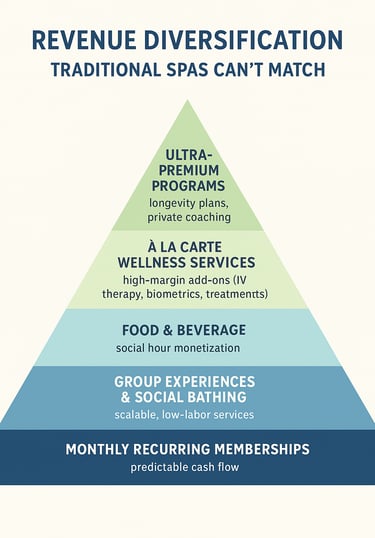
FAQ's
Q: What is a social wellness club?
A: A social wellness club is a membership-based facility that combines fitness, spa services, food and beverage, and community programming in a single "third place" environment designed for social connection. Unlike traditional gyms focused on equipment access or spas focused on treatments, social wellness clubs prioritize community experiences like group saunas, guided breathwork sessions, and social spaces. Remedy Place positions itself as the "world's first social wellness club," creating an environment for members to engage in high-tech remedies together in a social self-care setting.
Q: How much do social wellness club memberships cost?
A: Membership pricing varies dramatically by positioning and market. Othership charges $51 per month, making it the most accessible option. The Well charges $375 per month plus a $500 registration fee. Continuum Club operates at the ultra-premium end with $10,000 per month memberships capped at 250 members. Most clubs fall in the $150-400 monthly range, with additional revenue from à la carte services, events, and food and beverage.
Q: What's the difference between a social wellness club and a traditional gym?
A: The core difference is value proposition and business model. Traditional gyms sell "access to equipment," while social wellness clubs sell "access to community," with 57% of active consumers stating that social interaction and connection are the main reasons they join a fitness community. This translates to measurably better retention: traditional gyms average 60.6% retention while community-based models achieve 75-80% retention. Social wellness clubs also generate diversified revenue through services, food and beverage, events, and corporate partnerships beyond membership fees.
Q: How profitable are social wellness clubs compared to traditional spas?
A: Social wellness clubs restructure the cost base to be significantly more profitable. Traditional spas have labor costs as high as 55% of total wellness revenue due to one-on-one service models, while social wellness clubs reduce labor costs to 20% or less through communal experiences like social bathing and group classes. The community model also generates 2.5x higher member lifetime value through superior retention. Othership achieves $140,000 revenue per employee, demonstrating operational efficiency.
Q: Social wellness club vs boutique fitness studio: Which is more profitable?
A: Social wellness clubs typically outperform boutique studios through revenue diversification and higher average revenue per member. While boutique studios rely primarily on class fees and some retail, social wellness clubs stack revenue from memberships, à la carte wellness services, food and beverage, corporate events, and product lines. Remedy Place's corporate events business grew 65% year-over-year, facilitating over 13,000 ice baths for partners like BMW and HBO. Both achieve strong retention (75-80%), but clubs capture more wallet share per member through multiple touchpoints.
Q: How long does it take for a social wellness club to break even?
A: Break-even timelines vary significantly based on positioning, but the club shouldn't be evaluated as a standalone P&L. Wellness real estate commands 10-25% sales premiums over traditional real estate. For a developer, the club may show negative cash flow in years one through three while adding millions in property value. For hotel operators, the club drives occupancy and ADR premiums across the entire property. The Well secured 400 members before its September 2019 opening, demonstrating that strong pre-launch demand can accelerate break-even for well-positioned concepts.
Further reading on our blog: Further reading on our blog: 'Luxury Wellness Trends 2026.'
Explore our Spa & Wellness Consultancy to scope project phases and services.
See how we structure Fitness and Leisure concepts before you commit to equipment.
Learn why Luxe Wellness Spaces blends design, operations, and growth under one roof.
Reference List:
Global Wellness Institute - 2024 Global Wellness Economy Monitor - Wellness economy market sizing ($6.3 trillion) and growth projections through 2028.
Boston Hospitality Review & IPG Research - Wellness real estate growth rates (18.1% CAGR) and property value premiums (10-25%).
U.S. Surgeon General & UC Health - Loneliness epidemic statistics and $6.7 billion Medicare cost impact.
ABC Fitness via Athletech News - Consumer behavior data showing 57% join gyms for social connection.
Hospitality Net - Labor cost analysis comparing traditional spa (55%) vs. social wellness models (20%).
Brookings Institution - Third Place theory and community-building wellness spaces.

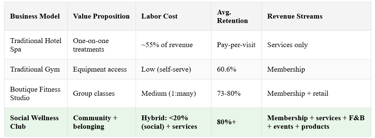
About The Author
Daryn Berriman is the Founder and Principal Consultant of Luxe Wellness Spaces, a consulting-led studio blending operational expertise and design excellence to create wellness businesses that perform, and spaces that guests love.

